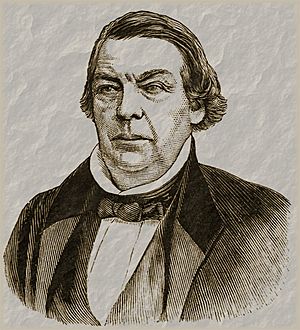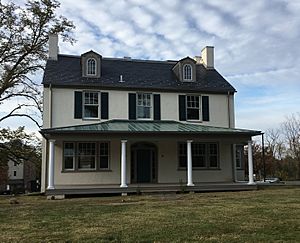Bartholomew Fussell facts for kids
Bartholomew Fussell (1794–1871) was an American abolitionist. This means he worked to end slavery. He was a hero who helped many enslaved people escape to freedom.
Dr. Fussell was a key part of the Underground Railroad. This was a secret network of safe houses and routes. It helped enslaved people travel from the Southern states to freedom in the North or Canada. He offered his home in Kennett Square, Pennsylvania as a safe house. He also helped people in other parts of Pennsylvania and Ohio. It's thought he helped about 2,000 enslaved people escape.
He was also a founding member of the American Anti-Slavery Society. This group worked hard to end slavery. Dr. Fussell believed women should be doctors. He helped start the Women's Medical College of Pennsylvania. He was a practicing physician and even gave medical care to those escaping slavery.
Contents
Early Life and Education
Bartholomew Fussell was born in 1794. His family were Quakers in Chester County, Pennsylvania. Quakers believed in equality for all people. His father and sister, Esther, really wanted him to get a good education.
As a young man, he moved to Maryland. He felt there were better schools there. He opened a school in Little Falls, Maryland, and taught students. At night, he studied medicine. He eventually became a doctor from the Medical College of Baltimore.
He also started a Sunday school for African-American enslaved people. This was in Bush River Neck, Maryland. He taught them to read the Bible. This was a brave and risky thing to do back then. Many people did not approve. Through his family, he met other Quakers who were against slavery. He started speaking out against slavery himself. This made some local slaveholders angry.
Family Life and Home
After finishing his studies, Dr. Fussell returned to Chester County, Pennsylvania. He started his medical practice there. In 1826, he married Lydia Morris. They made their home in Kennett Square, Pennsylvania. This house became known as "The Pines."
"The Pines" was a very important safe house for the Underground Railroad. The people who lived there before them, Jonathan and Ann Thomas, had already used it to help runaway enslaved people. They had done this from 1805 to 1830.
Bartholomew and Lydia had several children. Their daughter, Susan Fussell, became a well-known educator and nurse. She also helped others through charity work. Lydia, Dr. Fussell's first wife, passed away in 1840. He later married Rebecca Churchman Hewes in 1841. They had one child together.
Helping on the Underground Railroad
In Pennsylvania, Dr. Fussell worked closely with another abolitionist named Thomas Garrett. Dr. Fussell began sheltering enslaved people who Garrett brought to his home. He not only gave them a safe place to hide but also used his medical skills. He treated sick or injured runaway enslaved people at "The Pines."
His home was about a mile east of Kennett Square. This village was a major center for the abolitionist movement. "The Pines" had a secret root cellar. This was a perfect hiding spot for those escaping slavery. It also had a second exit for a quick escape if needed. Dr. Fussell and his wife Lydia often welcomed other abolitionists to their home.
In 1833, Dr. Fussell was one of the first people to sign a special document. It was called the Declaration of Sentiments of the American Anti-Slavery Society. This document explained the group's strong beliefs against slavery. It was signed at their first meeting in Philadelphia, Pennsylvania.
In the late 1830s, Dr. Fussell moved about 20 miles north. He went to West Vincent, Pennsylvania. His farm was next to his sister Esther Lewis's home. There, he worked with his sister, her daughters, Thomas Garrett, and other abolitionists. They all helped the Underground Railroad. His work was similar to what Elijah F. Pennypacker was doing in other parts of Chester County.
After his first wife Lydia died, Dr. Fussell moved to York, Pennsylvania with his new wife Rebecca. But the work at "The Pines" continued. His brother and nephew moved into the West Vincent home. They kept helping enslaved people escape.
The activities of the Underground Railroad became even more important after 1850. That year, the Fugitive Slave Law was passed. This law made it much harder and more dangerous to help enslaved people. It also meant harsher punishments for those who helped. But Dr. Fussell became even more involved.
In 1851, he helped three people escape after the Christiana Riot. He gave them a safe place to hide at the Lewis family home. Dr. Fussell remained an active member of the Pennsylvania Anti-Slavery Society. He continued this work until the end of the American Civil War. This war finally ended slavery.
Dr. Fussell was like a "conductor" or "stationmaster" on the Underground Railroad. These were terms used to describe people who helped guide and shelter those seeking freedom.
His important work is written about in an early book. It's called The Underground Railroad Records. This book was written in 1872 by William Still. He was an African-American abolitionist. In 2016, Dr. Fussell's home, "The Pines," was bought by Kennett Township. This was done to protect its history.
Helping Women Become Doctors
Dr. Fussell saw that women had very few chances to become doctors. His own sister, Esther, had wanted to study medicine but couldn't. This made him want to help.
In 1840, he started teaching basic medicine classes to women. After that, he began a campaign to support women becoming physicians. In 1846, he held a meeting with six other doctors and his niece, Graceanna Lewis. They talked about how important it was for women to have careers in medicine. This meeting eventually led to the creation of the Women's Medical College of Pennsylvania in 1850. Even though he didn't directly create it, his efforts were a big part of its beginning.
Later Life and Passing
After the American Civil War ended and slavery was abolished, Dr. Fussell spent a lot of time in Pendleton, Indiana. He stayed at his son Joshua Fussell's home there. However, he passed away in West Pikeland Township, Pennsylvania. He was at the home of his son, Dr. Morris Fussell. Dr. Fussell is buried next to his first wife, Lydia. They are at the Pikeland Friends Burial Ground in Phoenixville, Pennsylvania.



